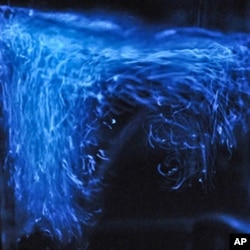Of all the wondrous survival strategies nature’s creatures have evolved, one of the most dazzling is the ability of some animals to generate light to find their prey, avoid becoming prey and to attract a mate.
A museum exhibit in New York explores this ability, known as bioluminescence.
The American Museum of Natural History’s “Creatures of Light” exhibit features jellyfish that glow green, anglerfish whose lantern-like bulbs dangle from their foreheads and luminous glowworms that hang mucus-like strands from cave ceilings to attract and ensnare their prey.
“Some of the stuff is just incredible,” says museum provost Michael Novacek, who's especially intrigued by the bioluminescent creatures that inhabit the deep oceans. “They are probably the most inventive of all the bioluminescent creatures because they have to be. Because it’s totally dark. So that’s probably where the greatest potential for discovery is, too. There are so many things down there we haven’t even described.”
Up to 90 percent of the habitable earth is underwater, and most of the animals that live in the pitch black water below depths of 700 meters are bioluminescent. That’s where the anglerfish and hatchetfish live.
Exhibit curator John Sparks is a marine biologist who specializes in pony fish, which live closer to the surface. They can emit light during the daytime that matches their physical background and makes them virtually invisible to predators.
“We’ve been able to reconstruct the evolution of the light organ system in this group from something very simple - just a simple out-pouching around the esophagus - to this elaborate system we see today," he says, "where the males shoot lights out of all different sides, their head, their flank, their gills, their mouth, and each species has a specific pattern it emits.”
Many bioluminescent animals use light to deceive their prey. The glowing pattern on the underbelly of the large cookie cutter shark, for example, mimics the rippling play of sun and moonlight on the surface of the water. From below, potential predators can mistake the small dark patches between the shark’s lights for small, edible fish. When a fish moves in for what it thinks will be a quick meal, it can become a meal for the shark instead.
Other animals, such as the tube shoulder fish, shoot bioluminescent fluid from their sides. Cardinal fish startle away predators by vomiting jets of brilliant liquid. And even bitten-off chunks of sea cucumbers stay luminous in the mouth of its predator.
“So then the predator is now lit up and has to get away to avoid being eaten by something else,” Sparks says.
Some “creatures of light,” like dinoflagellates, live on the water’s surface. Their blue-green sparkle is familiar to nighttime swimmers in the shallow bays of Puerto Rico and other tropical locales.
The exhibit also showcases some of the many bioluminescent organisms that live on land and light up in a variety of colors. Dismalite gnats glow blue. Brilliant mushrooms from the American northeast radiate an intense yellow. A giant model of a millipede shows off the many-legged insect’s blue-green luminescence.
And, of course, there are the fireflies. Visitors can see a sampling of the world’s more than 2,000 firefly species, including a replica of one common North American firefly that museum artists have rendered 210 times its actual size.
University of Florida firefly expert Marc Branham, a consultant for the exhibition, has been fascinated since childhood by the light of the firefly.
“It is produced in these very specialized organs in their body that are photic organs, some of which are so highly modified that they have a reflective layer in the back, sort of like a headlight on a car and they push every photon out of the photic organ," Branham says. "It has been shaped through the millennia to be as efficient as possible.”
Each species of firefly uses a unique flashing pattern to attract its mates.
“But there are also other species where the female will give the flash pattern of another species to call in those males which she is not going to mate with but which she feeds on," Branham says. "So there are ‘femme fatales’ in the firefly world.”
The “Creatures of Light” exhibit continues at the American Museum of Natural History in New York until early 2013. The show is drawing large crowds, and the reviews so far have been glowing.











